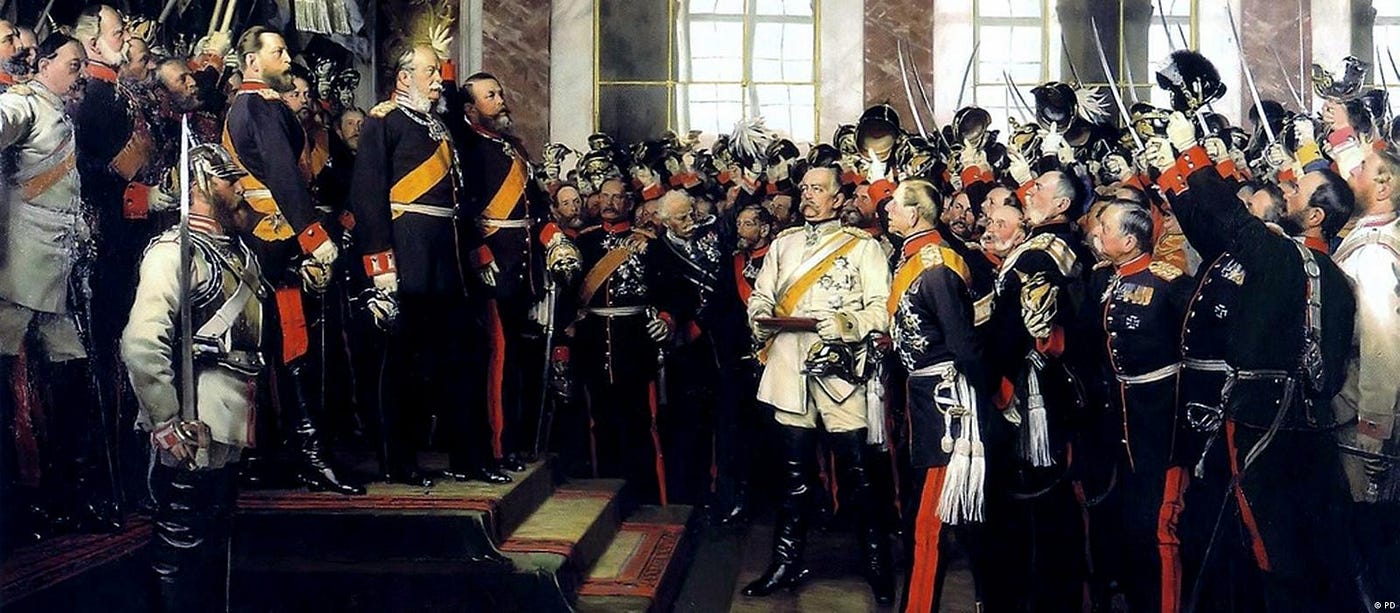
2.7 German Unification
Economic success, political failure, and diplomatic tension marked the idea of a unified Germany in the period after the Napoleonic Wars. Prussian merchants, with the support of the Prussian crown, established the customs and trade union known as the Zollverein in 1834.
To unify the north German states under Prussian control. to weaken Prussia's main rival, Austria, by removing it from the German Federation. to make Berlin, not Vienna, the centre of German affairs.
Proclamation of the German Empire, 1871 18 January 1871. At the end of the War of 1870, France lay defeated and invaded by its enemies.
Chancellor Bismarck proclaimed the German Empire in the Hall of Mirrors.
German Unification Summary
Before the German unification of 1871, the German states existed as a loose confederation that had limited economic and political cooperation. The two dominant German states were Prussia and Austria and there was competition between the two over who should be the leader of the German states.
By the mid-1800s, Prussia had become the more powerful of the two and its prime minister Otto von Bismarck played a clever game of using diplomacy and war to unite the German states under its leadership. A series of wars in the 1860s, culminating in the Prussian defeat of France in 1871 resulted in the German unification of 1871 under Prussian leadership.
Steps to German unification
Step 1- War with Denmark.
Step 2- Austrian-Prussian War.
7 Weeks War- 1866.
Step 3 – Creation of the Northern German Confederation – 1867.
Step 4 – Franco-Prussian War. (1870- 1871) By September of 1870, the Prussian army surrounded the main French force and captured approximately 83,000 prisoners (including Napoleon III).
https://www.youtube.com/watch?v=tq91I3TnWu4
Russo-Japanese War, 1905
In 1905, the imperial ambitions of Czarist Russia and Japan precipitated a war for control of Korea. While the Japanese decisively defeated the Russian fleet at the battle of Tsushima Straits, the war on land was far more costly to both sides. The Russians had established a strong defensive perimeter around Port Arthur, China, that consisted of bunkers, trenches, barbed wire, and machine gun emplacements. Both the Russians and Japanese possessed long-range artillery using high explosive shells.
The fighting around Port Arthur resulted in extremely high casualties for both the Russians and Japanese; the impact of modern artillery and automatic weapons was devastating on the battlefield. Although the Russo-Japanese War provided clear warnings of how the next major war would be fought, many military professionals took little account of the conflict.
Russo-Japanese War, (1904–05) Conflict between Russia and Japan over territorial expansion in East Asia. After Russia leased the strategically important Port Arthur (now Lüshun, China) and expanded into Manchuria (northeasternChina), it faced the increasing power of Japan.
The Treaty of Portsmouth formally ended the Russo-Japanese War of 1904–05. The negotiations took place in August in Portsmouth, New Hampshire, and were brokered in part by U.S. President Theodore Roosevelt.
Japan staged amphibious attacks on Korea and the Liaodong Peninsula, causing Russian forces to retreat to Mukden. In the Battle of Mukden (early 1905), the Japanese decisively defeated the Russians.
https://www.youtube.com/watch?v=deuzVsKMsTA
